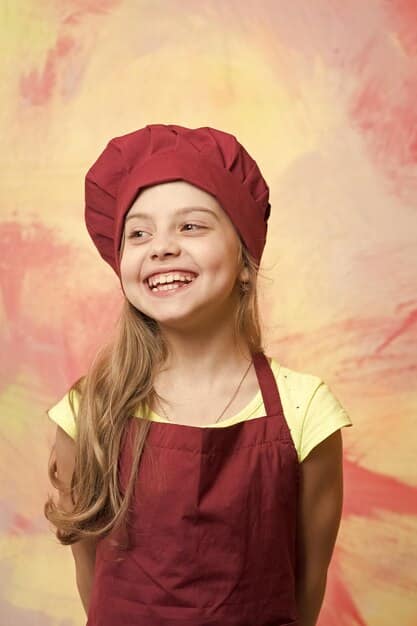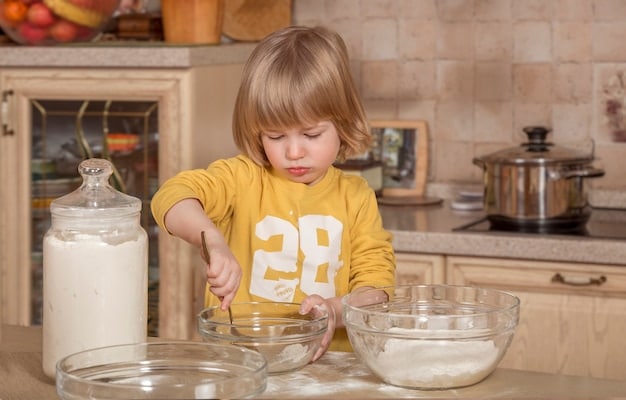Cooking with Kids: 5 Fun & Educational Recipes for Family Time

Cooking with kids offers a unique opportunity to bond while teaching valuable life skills; selecting recipes that are fun, educational, and age-appropriate ensures a successful and enjoyable culinary experience for the whole family.
Looking for a fun and educational activity to do with your kids? Cooking with kids is a wonderful way to spend quality time together, teach them valuable life skills, and create delicious memories that will last a lifetime. Forget the screens and aprons ready!
Embrace Family Fun: Why Cook with Your Kids?
Cooking is more than just following a recipe; it’s an adventure, a learning experience, and a fantastic way to bond with your children. Involving kids in the kitchen can spark their creativity, teach them about nutrition, and even improve their math skills. Plus, who doesn’t love a little extra help preparing dinner?
Benefits of Cooking with Kids
Cooking with kids offers a wide range of benefits that extend far beyond just preparing a meal. It’s a fun and engaging way to foster creativity, teach important life skills, and create lasting memories. Here are just a few of the many advantages:
- Develops Important Life Skills: Cooking with kids teaches essential skills like measuring, following instructions, and understanding basic kitchen safety. These skills build confidence and independence.
- Encourages Healthy Eating Habits: When kids are involved in the preparation of their meals, they are more likely to try new foods and develop a positive relationship with healthy ingredients.
- Boosts Math and Literacy Skills: Measuring ingredients, reading recipes, and understanding fractions are all ways that cooking can help reinforce math and literacy skills.
- Sparks Creativity and Imagination: Cooking allows kids to experiment with flavors, textures, and presentation, fostering their creativity and imagination.
Ultimately, cooking together is a valuable opportunity to connect with your children, share knowledge, and create enjoyable experiences. By making cooking a regular part of your family routine, you can help your kids develop a lifelong love of food and a healthy understanding of nutrition.
Getting Started: Tips for Success
Before diving into recipes, it’s important to set the stage for a positive and successful experience. Start by choosing age-appropriate recipes and tasks, and don’t be afraid to let go of perfection. Remember, the goal is to have fun and learn together!
Setting Up a Kid-Friendly Kitchen
Creating a safe and accessible kitchen environment is key to involving kids in the cooking process. Here are some tips to help you set up a kid-friendly kitchen:
- Designate a Safe Work Space: Ensure your child has a clear and clutter-free workspace. Use a sturdy step stool if they need help reaching the counter.
- Gather Necessary Tools and Equipment: Have child-sized utensils like measuring cups, spoons, and mixing bowls readily available. Sharp knives should only be used under close supervision.
- Emphasize Kitchen Safety: Teach your child about basic kitchen safety rules, such as washing hands, using oven mitts, and understanding the dangers of hot surfaces.
Choosing the Right Recipes
Selecting recipes that are both fun and educational is essential for engaging kids in the kitchen. Here are some guidelines for choosing the right recipes:
When selecting recipes, consider your child’s preferences and dietary needs. Opt for recipes that are visually appealing, have simple instructions, and offer opportunities for hands-on participation. Remember, the goal is to make cooking an enjoyable and rewarding experience for everyone involved.

Recipe 1: Rainbow Veggie Skewers with Peanut-Free Dip
These colorful skewers are not only visually appealing but also a great way to introduce kids to a variety of vegetables. Plus, the peanut-free dip makes it a safe and tasty option for school lunches or snacks.
Ingredients
Choose a variety of colorful vegetables such as:
- Cherry tomatoes
- Cucumber slices
- Bell pepper chunks (red, yellow, and green)
- Carrot sticks
- Broccoli florets
For the dip:
- 1/2 cup sunflower seed butter
- 2 tablespoons honey
- 1 tablespoon lemon juice
- 2 tablespoons water
Instructions
- Wash and prepare the vegetables by cutting them into bite-sized pieces.
- Let your child help thread the vegetables onto skewers in a colorful pattern.
- In a small bowl, whisk together the sunflower seed butter, honey, lemon juice, and water until smooth.
- Serve the veggie skewers with the dip for a healthy and fun snack.
These Rainbow Veggie Skewers not only boost a child’s nutritional intake but also teach them about different colors and textures. It’s a perfect blend of fun and healthy eating!
Recipe 2: Mini Pizzas on English Muffins
Who doesn’t love pizza? This recipe allows kids to customize their own mini pizzas, making it a fun and interactive mealtime activity. Using English muffins as the base makes it quick and easy.
Ingredients
- English muffins, split in half
- Pizza sauce
- Shredded mozzarella cheese
- Toppings of your choice (pepperoni, mushrooms, olives, bell peppers)
Instructions
- Preheat the oven to 350°F (175°C).
- Let your child spread pizza sauce on each English muffin half.
- Sprinkle with mozzarella cheese and add your favorite toppings.
- Bake for 10-12 minutes, or until the cheese is melted and bubbly.
Mini Pizzas on English Muffins are a fantastic way to get kids involved in meal preparation and learn about different food groups. It’s a simple yet satisfying recipe that makes mealtime interactive and fun!
Recipe 3: Fruit Salad Parfaits
This recipe is a refreshing and healthy treat that kids can easily assemble themselves. It’s a great way to encourage them to eat more fruit and learn about layering flavors and textures.
Ingredients
- Assorted fresh fruits (berries, bananas, melon, kiwi)
- Yogurt (vanilla or flavored)
- Granola or crushed graham crackers
Instructions
- Wash and cut the fruit into bite-sized pieces.
- Have your child layer yogurt, fruit, and granola in a clear glass or cup.
- Repeat layers until the glass is full.
- Enjoy immediately or chill for later.
Fruit Salad Parfaits are both visually appealing and delicious, making them a hit with kids of all ages. This recipe not only promotes healthy eating habits but also allows children to express their creativity and independence in the kitchen.

Recipe 4: Cheesy Quesadillas
Quesadillas are a quick and easy meal that can be customized to suit any taste. They’re perfect for lunch, dinner, or even a snack, and kids love helping to fill and fold them.
Ingredients
- Flour tortillas
- Shredded cheese (cheddar, Monterey Jack, or a blend)
- Optional fillings: cooked chicken, black beans, salsa, chopped vegetables
Instructions
- Sprinkle cheese (and any other fillings) on one half of a tortilla.
- Fold the other half of the tortilla over the fillings.
- Cook in a skillet over medium heat for 2-3 minutes per side, or until the cheese is melted and the tortilla is golden brown.
- Cut into wedges and serve.
Cheesy Quesadillas are a versatile and kid-friendly recipe that can be adapted to incorporate various ingredients and flavors. This recipe is a great opportunity for kids to practice their fine motor skills by carefully filling and folding the tortillas. Plus, it’s a simple and satisfying meal that everyone will enjoy.
Recipe 5: Ants on a Log
This classic snack is a fun and nutritious way to get kids excited about eating celery. The combination of celery, peanut butter (or sunflower seed butter), and raisins creates a playful and satisfying treat.
Ingredients
- Celery stalks
- Peanut butter or sunflower seed butter
- Raisins
Instructions
- Wash and cut the celery stalks into 3-4 inch pieces.
- Let your child spread peanut butter or sunflower seed butter into the groove of each celery stick.
- Place raisins on top of the peanut butter to resemble ants.
- Enjoy as a healthy and playful snack.
Ants on a Log are a quick, easy, and nutritious snack that captures the imagination of kids. This recipe encourages children to incorporate vegetables into their snack routine and promotes healthy eating habits from a young age. It’s a simple yet satisfying way to fuel their bodies with wholesome ingredients.
| Key Takeaway | Brief Description |
|---|---|
| 🧑🍳 Cooking Skills | Learn basics like measuring, mixing, and kitchen safety. |
| 🍎 Healthy Eating | Encourage trying new fruits and vegetables. |
| 🍕 Recipe Variety | Explore veggie skewers, mini pizzas, and fruit parfaits. |
| 🤝 Bonding Time | Create lasting memories with fun, interactive cooking. |
[Frequently Asked Questions]
▼
Kids as young as 3 can help with simple tasks like washing vegetables or stirring ingredients. As they get older, they can take on more complex tasks like measuring and chopping.
▼
Always supervise children in the kitchen. Teach them about kitchen safety, such as using oven mitts, washing hands, and avoiding hot surfaces. Keep sharp knives out of reach or use them only with supervision.
▼
Start with simple recipes like fruit salads, sandwiches, or quesadillas. These recipes require minimal cooking and offer plenty of opportunities for kids to get involved in the preparation.
▼
Involve picky eaters in the recipe selection and preparation process. Encourage them to try new foods and offer alternative ingredients. It’s alright if they don’t like everything; the goal is to expose them to various flavors.
▼
Turn cooking into a game by letting kids measure ingredients, create colorful patterns with vegetables, or design their own pizzas. Use cooking as an opportunity to teach them about nutrition, fractions, and kitchen safety.
Conclusion
Cooking with kids is an enriching experience that benefits both parents and children. By choosing age-appropriate recipes, prioritizing safety, and making it fun, you can create lasting memories and instill valuable life skills. So, gather your little chefs and embark on a culinary adventure together!





